What's Happening?
NASA's Antarctic Impulsive Transient Antenna (ANITA) has detected unusual radio signals emanating from beneath Antarctica's ice, challenging current models of particle physics. These signals, recorded
between 2016 and 2018, appeared to originate from below the horizon, defying expectations. The signals were initially thought to indicate new types of particles or interactions. However, further investigation using data from the Pierre Auger Observatory suggests that these anomalies are not indicative of new physics but add complexity to existing models.
Why It's Important?
The detection of these anomalous signals has implications for our understanding of cosmic phenomena and particle physics. While the signals do not suggest new physics, they provide valuable data that could refine existing models and improve our understanding of neutrinos and cosmic rays. This research highlights the challenges in detecting and interpreting signals from elusive particles like neutrinos, which are abundant yet difficult to detect.
What's Next?
Researchers are designing and building new detectors, such as the PUEO, to capture sensitive neutrino signals and better understand these anomalies. The new detector aims to improve sensitivity and provide clearer insights into the nature of these signals, potentially leading to breakthroughs in particle physics.
Beyond the Headlines
The study emphasizes the importance of international collaboration in advancing scientific knowledge. By cross-referencing data from multiple experiments, researchers can filter out background noise and eliminate the possibility of other known particle-based signals, enhancing the accuracy of their findings.














